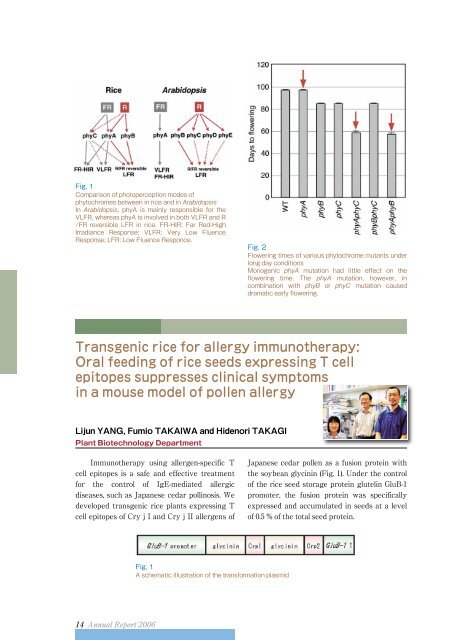Annual Report 2006
Annual Report 2006
Annual Report 2006
You also want an ePaper? Increase the reach of your titles
YUMPU automatically turns print PDFs into web optimized ePapers that Google loves.
Fig. 1<br />
Comparison of photoperception modes of<br />
phytochromes between in rice and in <br />
In phyA is mainly responsible for the<br />
VLFR, whereas phyA is involved in both VLFR and R<br />
/FR reversible LFR in rice. FR-HIR: Far Red-High<br />
Irradiance Response; VLFR: Very Low Fluence<br />
Response; LFR: Low Fluence Responce.<br />
Fig. 2<br />
Flowering times of various phytochrome mutants under<br />
long day conditions<br />
Monogenic mutation had little effect on the<br />
flowering time. The mutation, however, in<br />
combination with or mutation caused<br />
dramatic early flowering.<br />
Transgenic rice for allergy immunotherapy:<br />
Oral feeding of rice seeds expressing T cell<br />
epitopes suppresses clinical symptoms<br />
in a mouse model of pollen allergy<br />
Lijun YANG, Fumio TAKAIWA and Hidenori TAKAGI<br />
Plant Biotechnology Department<br />
Immunotherapy using allergen-specific T<br />
cell epitopes is a safe and effective treatment<br />
for the control of IgE-mediated allergic<br />
diseases, such as Japanese cedar pollinosis. We<br />
developed transgenic rice plants expressing T<br />
cell epitopes of Cry j I and Cry j II allergens of<br />
Japanese cedar pollen as a fusion protein with<br />
the soybean glycinin (Fig. 1). Under the control<br />
of the rice seed storage protein glutelin GluB-1<br />
promoter, the fusion protein was specifically<br />
expressed and accumulated in seeds at a level<br />
of 0.5 % of the total seed protein.<br />
Fig. 1<br />
A schematic illustration of the transformation plasmid













